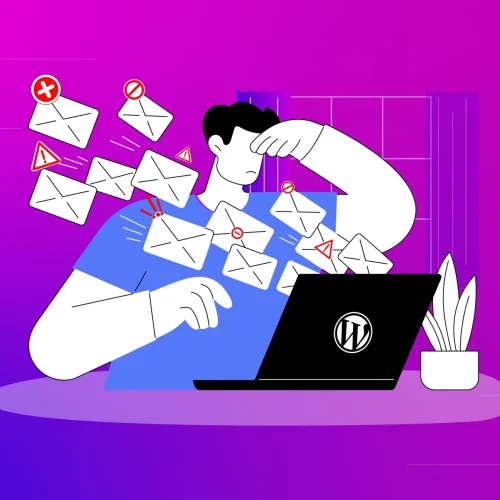Before we get into how to resolve blacklist issues, let’s first understand what an email blacklist actually is.Definition of an Email Blacklist
In simple terms, an email blacklist is a compiled list of IP addresses or domains that are flagged as sources of spam or unwanted emails. These lists are maintained by various organizations, email service providers (ESPs), and Internet Service Providers (ISPs) to protect users from receiving unwanted or malicious emails.
Why Do Blacklists Exist?
Think of an email blacklist as the gatekeeper of your inbox. Just like how security guards prevent unauthorized people from entering a building, email blacklists block emails from sources that are deemed untrustworthy or harmful. This protects users from spam, phishing attempts, and other malicious content.
How Does it Work?
When an email provider like Gmail, Yahoo, or Outlook receives an email, they run it through filters to determine if it should be delivered to the recipient’s inbox or sent to the spam folder. These filters look at several factors, including whether the sender’s IP or domain is on a blacklist.
How to Check If You’re Blacklisted
Now that you know what an email blacklist is, how do you know if you’re on one? Let’s explore some ways to check.
Use Blacklist Checking Tools
There are several free online tools you can use to check if your domain or IP address is on a blacklist. Some popular tools include:
- MXToolbox
- Spamhaus
- Barracuda Reputation Block List
These tools will scan multiple blacklists at once and let you know if your domain or IP has been flagged.
Monitor Email Delivery Rates
If you’ve noticed a significant drop in your email open rates or increased bounce rates, this could be a sign that you’re on a blacklist. A sudden drop in engagement usually indicates that your emails are either not reaching recipients or are being directed to spam folders.
Watch for Bounce Back Messages
Another way to check if you’ve been blacklisted is to pay attention to the bounce-back messages you receive. If your emails are repeatedly bouncing back with error messages that mention spam or filtering issues, this could be an indication that your domain has been flagged.
Common Reasons for Getting Blacklisted
You might be wondering, “How did I end up on a blacklist in the first place?” Here are some common reasons why your domain or IP might have been flagged.
|
|
|
|
Passive Spam Block List (PSBL)
|
|
|
|
|
|
|
Composite Blocking List (CBL)
|
|
|
|
|
|
|
|
|
|
|
|
|
|
|
Spamhaus Block List (SBL)
|
|
|
|
|
|
|
Sending Emails Without Permission
One of the most common reasons for being blacklisted is sending emails to people who didn’t give you permission. This includes purchasing email lists or sending unsolicited messages. Always ensure that your recipients have opted in to receive your emails.
High Spam Complaints
If a large number of your recipients mark your emails as spam, email service providers will take notice. Consistent complaints can quickly get your domain flagged and blacklisted.
Poor Email Hygiene
Sending emails to invalid or outdated addresses can also harm your sender reputation. Regularly clean and update your email list to avoid sending to fake or inactive addresses.
Hacked Accounts
If your email account or server gets hacked and is used to send spam, you might find yourself on a blacklist even though you didn’t do anything wrong. In these cases, it’s important to secure your accounts as soon as possible.
How to Get Removed from a Blacklist
So, what do you do if you find out you’ve been blacklisted? Don’t panic! Here’s a step-by-step guide to getting removed.
Identify the Blacklist
First, you need to identify which blacklist you’re on. Use one of the tools mentioned earlier to see where your domain or IP address is flagged. Knowing which blacklist you’re on will help you determine the best course of action for removal.
Follow Removal Instructions
Each blacklist has its own process for removing flagged IPs or domains. Some offer an online form for delisting, while others may require you to send an email request. Be sure to follow their specific instructions carefully.
Fix the Root Cause
Getting removed from a blacklist won’t do much good if the issue that caused you to get blacklisted in the first place hasn’t been addressed. Whether it’s cleaning up your email list, improving your content, or tightening your email security, make sure the root cause is resolved to prevent future problems.
How Email Blacklisting Affects Deliverability
Being blacklisted can have serious consequences for your email marketing efforts. Here’s how it impacts your overall email deliverability.
Lower Inbox Placement
When you’re on a blacklist, your emails are more likely to be sent to the spam folder rather than the recipient’s inbox. This drastically reduces the chances of your emails being seen and opened.
Increased Bounce Rates
Blacklisted domains often experience higher bounce rates, as recipient servers reject incoming emails. This not only affects your current email campaign but can also damage your reputation, making it harder to reach inboxes in the future.
Damaged Sender Reputation
Your sender reputation is a measure of how trustworthy your domain or IP address is. Being on a blacklist can severely damage your reputation, making it more difficult to reach your audience even after you’ve been removed from the blacklist.
How to Prevent Getting Blacklisted
Prevention is always better than cure. Let’s explore some best practices to ensure your emails stay off blacklists
Maintain a Clean Email List
Regularly clean and update your email list to ensure that you’re only sending to valid and engaged recipients. Remove inactive or bounced email addresses to improve your deliverability.
Use Double Opt-ins
Using a double opt-in process can significantly reduce the chances of sending to fake or incorrect email addresses. This also ensures that your recipients truly want to hear from you.
Monitor Email Metrics
Keep a close eye on your email engagement metrics, such as open rates, click-through rates, and bounce rates. If you notice a sudden drop in performance, take immediate action to identify and resolve the issue.
Avoid Spam Trigger Words
Certain words and phrases can trigger spam filters, even if your content is legitimate. Avoid using overly promotional language and spammy words like “free,” “winner,” or “limited time offer” in your email subject lines and content.
Use a Reputable Email Service Provider
Choosing a reliable
email service provider (ESP) that follows best practices for email deliverability can help keep your emails from being flagged. Look for an ESP that offers tools for monitoring your sender reputation and email performance.
Getting blacklisted can be a major headache, but with the right knowledge and tools, you can resolve the issue and improve your email deliverability. By understanding why blacklisting happens, taking steps to get removed, and following best practices to prevent it in the future, you






